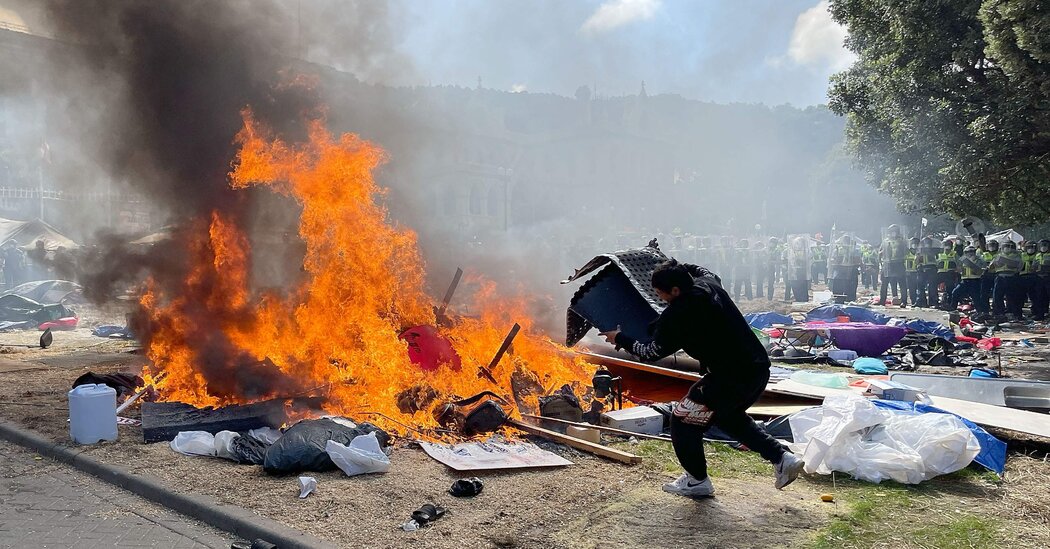
For more than three weeks, hundreds of protesters have disabled the center of New Zealand’s capital city, occupying the area in front of Parliament and issuing increasingly violent threats to politicians and other public figures in an ostensible battle against the country’s vaccine mandates.
On Wednesday, the 23rd day of the protest, the police began an aggressive clampdown, descending on the site in Wellington at 6 a.m., dismantling tents, toilets, a kitchen and other camp infrastructure, and urging the demonstrators to leave. Eventually, most did — but not without a fight.
In chaotic and sometimes bloody clashes, protesters wielded fire extinguishers, paint-filled projectiles, homemade plywood shields and pitchforks. Some lobbed cobblestones at officers. Others piled detritus onto gas-fueled fires, including one that caused an explosion at a playground near Parliament.
Protest leaders, against a soundtrack of the national anthem and the 1980s Maori pop song “Poi E,” urged demonstrators to hold the line and called the police “the Gestapo.” Officers, many bearing riot shields, responded with pepper spray and rubber bullets. At least 60 people were arrested, and three officers were taken to hospitals.
Such scenes are rare in New Zealand, a country known for its relative remoteness, serenity and stability. In this case, though, the police had expected “hostility, resistance and violence,” Prime Minister Jacinda Ardern said at a news conference. “That is what they and Wellingtonians have experienced for several weeks now.”
As the protest entrenched itself, she said, the police had avoided escalating the situation. But growing violence had left officers few alternatives in “trying to bring this occupation to a conclusion.”
The occupation, which was inspired by the recent antigovernment protest by truck drivers in the Canadian capital, Ottawa, was a response to New Zealand’s highly restrictive approach to the pandemic, which allowed the country to go months without a single case of community transmission.
The restrictions appear to have alienated a small group of New Zealanders, many of whom have been left without work after refusing to abide by the country’s sweeping vaccine mandates.
The first days of the protest had a peaceful, even carnivalesque, atmosphere as demonstrators spread mud and hay on the lawn outside Parliament and set up their campsite.
But over the weeks that followed, the makeup of the crowd changed, resulting in far greater violence and forcing the police to intervene, Andrew Coster, the police commissioner, said at a news conference on Wednesday. “The harm being done far outweighs any legitimate protest,” he added.
The protest was unpopular from the start: In a poll conducted about a week into it, 61 percent of those surveyed opposed the occupation. Over time, hostility toward the protesters grew even larger, particularly as people living in Wellington encountered blocked-off streets, harassment and violence from demonstrators, and an increasingly smelly protest site.
As in Canada and other places racked by pandemic-related protests, a segment of people demonstrating against virus restrictions in New Zealand were gradually subsumed into the far right.
In a working paper published late last year, members of the New Zealand think tank Te Punaha Matatini had warned that the two groups were merging in a troubling way. “The most recent Covid-19 outbreak and the vaccine are highly visible, potent symbols used to push various far-right and conservative ideologies,” the authors of the paper wrote.
The Coronavirus Pandemic: Key Things to Know
Vaccine protection in adolescents. Five months after immunization, two doses of the Pfizer vaccine appeared to offer virtually no defense against moderate illness caused by Omicron among adolescents aged 12 to 17 years, according to new C.D.C. data. Booster shots, however, dramatically increased the protection.
“Telegram channels and groups proliferate content which is violent, far-right and related to the conspiracy theory QAnon, signaling a near-frictionless shifting of New Zealanders from vaccine hesitancy, to vaccine resistance and then to content reflective of wider conspiratorial ideologies,” they added.
By dusk on Wednesday, the police had cleared most of the protest site, prompting some remaining demonstrators to flee rather than face them. Some descended on the city’s nearby central train station, and at least one group headed for camper van parking areas in Porirua, 50 miles west of the capital. Several dozen people remained on the streets in the area around Parliament.
Speaking at the news conference, Ms. Ardern praised the police and said two reviews would take place to determine if more could have been done to prevent the occupation. She expressed hope that the day’s events would not change how New Zealanders recalled the pandemic response.
“When we look back on this period in our history, I hope we remember one thing,” Ms. Ardern said. “Thousands more lives were saved in the past two years by your actions as New Zealanders than were on that front lawn of Parliament today.”
Pete McKenzie contributed reporting.




